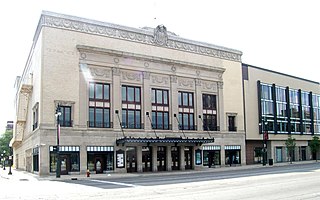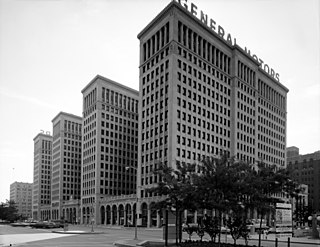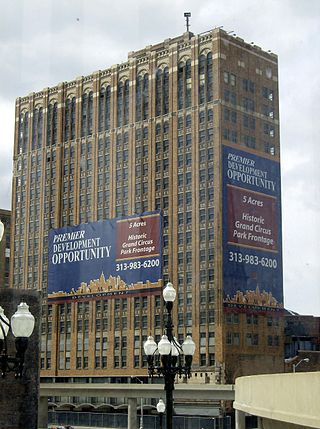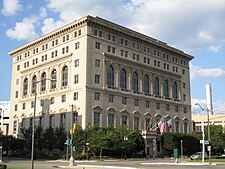
Orchestra Hall is an elaborate concert hall in the United States, located at 3711 Woodward Avenue in Midtown Detroit, Michigan. The hall is renowned for its superior acoustic properties and serves as the home of the internationally known Detroit Symphony Orchestra (DSO), the fourth oldest orchestra in the United States. With the creation of an adjoining auditorium for jazz and chamber music in 2003, Orchestra Hall became part of the Max M. and Marjorie S. Fisher Music Center. It was listed on the National Register of Historic Places in 1971.

Indian Village is a neighborhood located in Detroit, Michigan, bounded to the north and south by Mack Avenue and East Jefferson Avenue, respectively, along the streets of Burns, Iroquois, and Seminole. The district was listed on the National Register of Historic Places in 1972.

Grosse Pointe refers to an affluent coastal area next to Detroit, Michigan, United States, that comprises five adjacent individual cities. From southwest to northeast, they are:

Wirt Clinton Rowland was an American architect best known for his work in Detroit, Michigan.

Cadillac Place, formerly the General Motors Building, is a landmark high-rise office complex located at 3044 West Grand Boulevard in the New Center area of Detroit, Michigan. It was renamed for the French founder of Detroit, Antoine Laumet de La Mothe, sieur de Cadillac. It is a National Historic Landmark in Michigan, listed in 1985.

The Detroit Opera House is an ornate opera house located at 1526 Broadway Street in Downtown Detroit, Michigan, within the Grand Circus Park Historic District. The 2,700-seat venue is the home of productions of the Detroit Opera and a variety of other events. The theatre was originally designed by C. Howard Crane, who created other prominent theatres in Detroit including The Fillmore Detroit, the Fox Theater and the Detroit Symphony's Orchestra Hall. It opened on January 22, 1922.

The Gem Theatre is a performing arts theater located in Detroit, Michigan. Built in 1927 in the Spanish Revival style, it houses a two level theater with traditional row and aisle seating along with stage-level seating at cabaret tables. The Gem Theatre was listed on the National Register of Historic Places in 1985. It shares a lobby with the cabaret-style Century Theatre, built in 1903.

The Century Theatre in Detroit shares a lobby with the Gem Theatre. The theatre has seating at cabaret tables, and the stage hosts quirky shows, such as Forbidden Broadway, Menopause the Musical, and Late Nite Catechism. The theatre building houses a restaurant, The Century Grille, and is a popular downtown Detroit destination for weddings and private events.

Charles Howard Crane was an American architect who was primarily active in Detroit, Michigan. His designs include Detroit's Fox Theatre and Olympia Stadium, as well as LeVeque Tower in Columbus, Ohio, which remains that city's second tallest building.
Robert Sharoff is a Chicago-based architectural writer and author. He has written for a variety of publications including the New York Times, the Washington Post, the Chicago Tribune, and Chicago Magazine. He frequently collaborates with photographer William Zbaren.

The Buhl Building is a skyscraper and class-A office center in Downtown Detroit, Michigan. Architect Wirt C. Rowland designed the Buhl in a Neo-Gothic style with Romanesque accents. Constructed in 1925, it stands at 26 stories in the Detroit Financial District across Congress Street from the Penobscot Building and across Griswold Street from the Guardian Building, all of which were designed by Wirt C. Rowland. The Buhl Building stands on the corner of Congress St. West, and Griswold St. in Downtown Detroit. The building stands atop what used to be the Savoyard Creek near its confluence with the Detroit River. In 1836, the creek was covered and turned into a sewer. The Savoyard Club occupied the 27th floor of the Buhl Building from 1928 until its membership dwindled and the club closed in 1994.

The Cadillac Tower is a 40-story, 133.4 m (438 ft) Neo-Gothic skyscraper designed by the architectural firm of Bonnah & Chaffee at 65 Cadillac Square in downtown Detroit, Michigan. The building's materials include terra cotta and brick. It was built in 1927 as Barlum Tower. At the top of the tower is a tall guyed mast for local radio stations WMXD, WLLZ and television station WLPC-CD. It was listed on the National Register of Historic Places in 2005.

The Kales Building is a high-rise apartment building in downtown Detroit, Michigan. It is located 76 West Adams at the northeast corner of Adams Avenue West and Park Avenue, across from Grand Circus Park, in the Foxtown neighborhood, just north of Downtown. The building was designed by Albert Kahn and constructed in 1914, and stands at 18 floors, with one basement floor, for a total of 19 floors in height. It was originally named the Kresge Building and it was given its current name in 1930. Kahn went beyond the typical Chicago School and styled the Kales Building with a clean-lined detail façade with Neo-classical and Renaissance revival elements such as the hipped roof and arched upper windows.

The United Artists Theatre Building is a vacant high-rise tower in downtown Detroit, Michigan, standing at 150 Bagley Avenue. It was built in 1928 and stands 18 stories tall. The building was designed by architect C. Howard Crane in the renaissance revival architectural style, and is made mainly of brick. Until December 29, 1971, it was a first-run movie house and office space, and then after that, the theatre saw sporadic usage until 1973. The United Artists Theatre, designed in a Spanish-Gothic design, sat 2,070 people, and after closing served from 1978 to 1983 as the Detroit Symphony Orchestra's recording theater. After the theater closed, the office block struggled as tenants moved to suburbs. It finally closed in 1984. An original 10-story, vertical UA sign was replaced in the 1950s with a marquee that remained until 2005. The building once shared a lot with the now demolished Hotel Tuller.

The architecture of metropolitan Detroit continues to attract the attention of architects and preservationists alike. With one of the world's recognizable skylines, Detroit's waterfront panorama shows a variety of architectural styles. The post-modern neogothic spires of One Detroit Center refer to designs of the city's historic Art Deco skyscrapers. Together with the Renaissance Center, they form the city's distinctive skyline.
Eric J. Hill, Ph.D., FAIA, is a Professor of Practice in Architecture at the University of Michigan. He earned his bachelor's degree in Architecture in 1970 from the University of Pennsylvania, a Masters in Architecture from Harvard in 1972, and a Ph.D in Architecture from the University of Pennsylvania in 1976. He was a Marshall Research Fellow at Denmark's Royal Academy of Fine Arts from 1972 to 1973. He is the co-author, along with John Gallagher, of AIA Detroit: The American Institute of Architects Guide to Detroit Architecture. He has served as a Director of Urban Planning and Design at the Detroit firm of Albert Kahn Associates. He has participated in projects such as the promenade on the Detroit International Riverfront, the Detroit Opera House restoration, and the Cadillac Place redevelopment. He has received numerous awards from the American Institute of Architects.

The Bankers Trust Company Building is an office building located at 205 West Congress Street in Downtown Detroit, Michigan, within the Financial District. Designed by Wirt C. Rowland of Smith, Hinchman & Grylls and completed in 1925 the ornately modeled building is an exquisite example of Italian Romanesque Revival architecture.

St. Mary Roman Catholic Church, formally the Church of the Immaculate Conception of the Blessed Virgin Mary, is in the third oldest Roman Catholic parish in Detroit, Michigan. Designed by German-born Peter Dederichs and built for the formerly ethnic German parish of the 19th century, it is located at 646 Monroe Street in what is now considered the heart of the Greektown Historic District in downtown Detroit. It is often called "Old St. Mary's Church" to avoid confusion with other St. Mary's parishes: in the Redford neighborhood of Detroit, or in nearby Royal Oak, Monroe, or Wayne.
Andreas Duncan Carse (1875/76–1938) was an English artist.


















